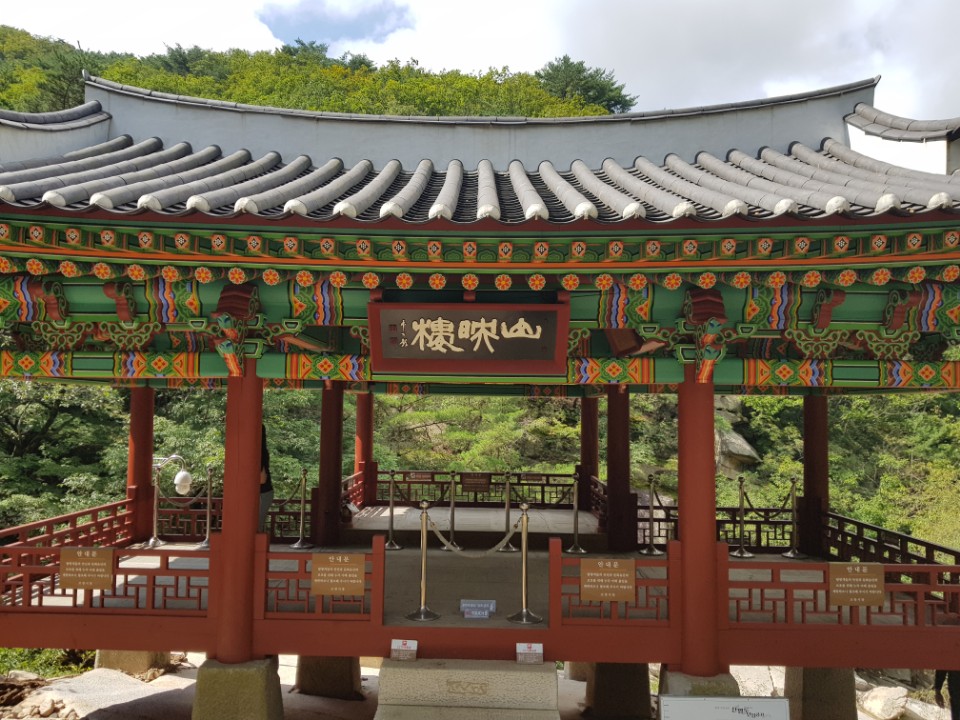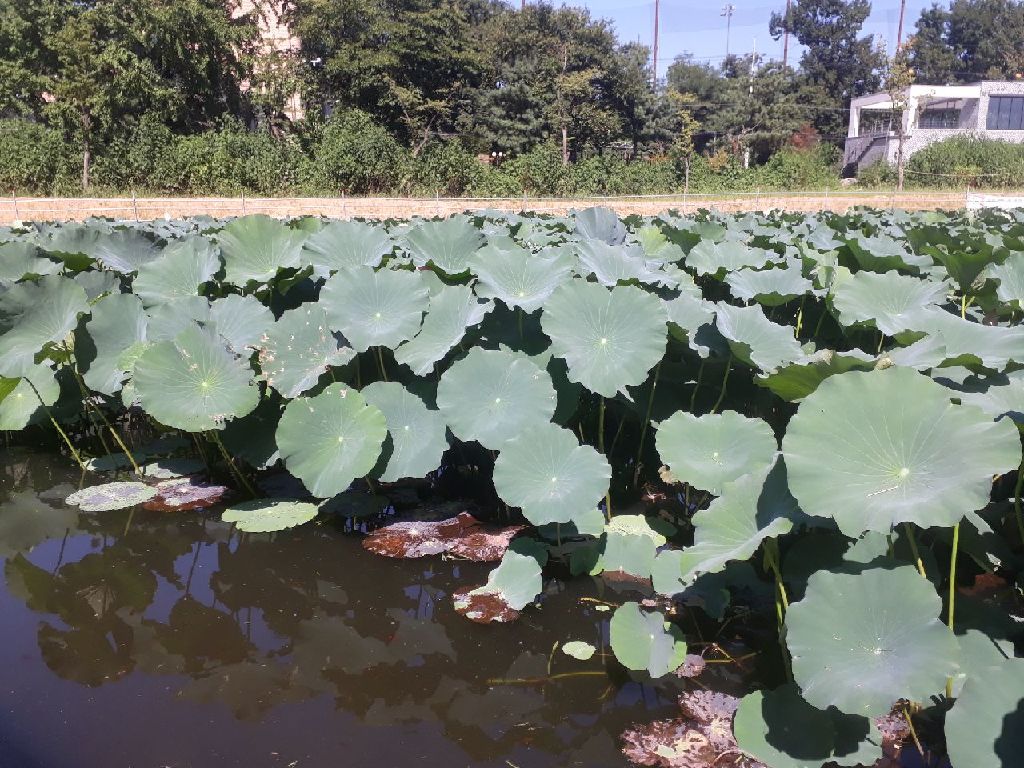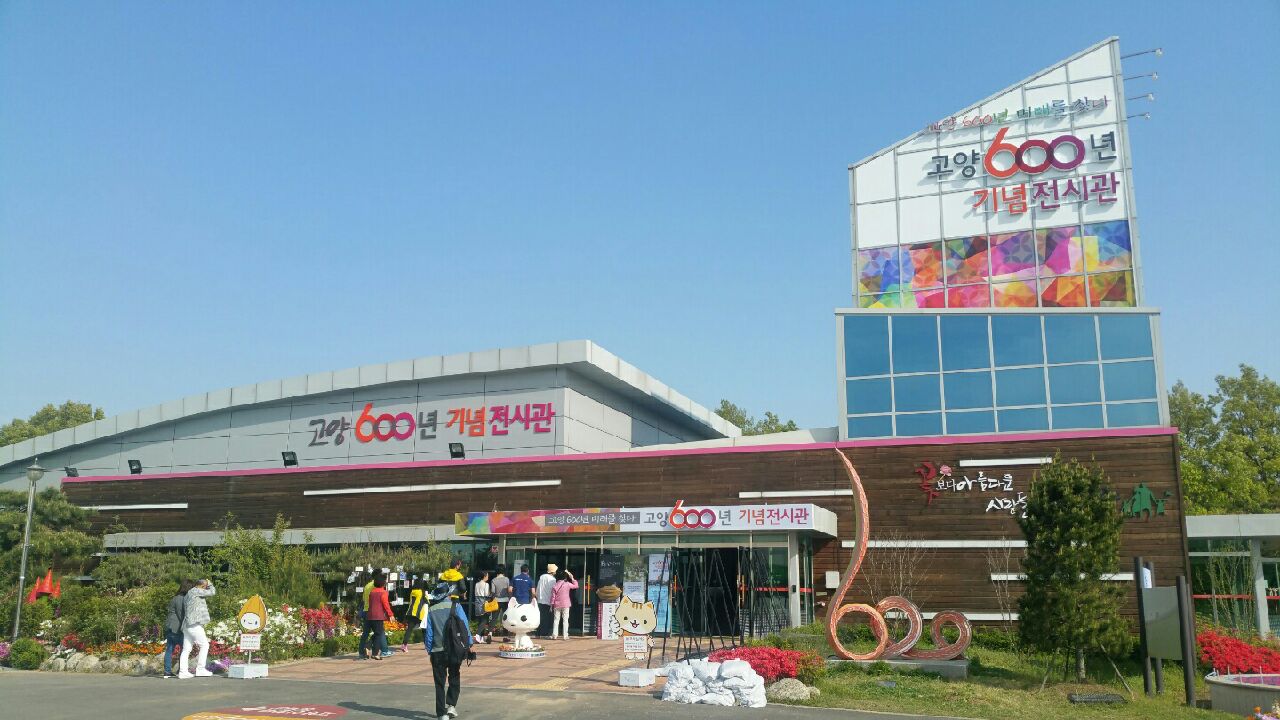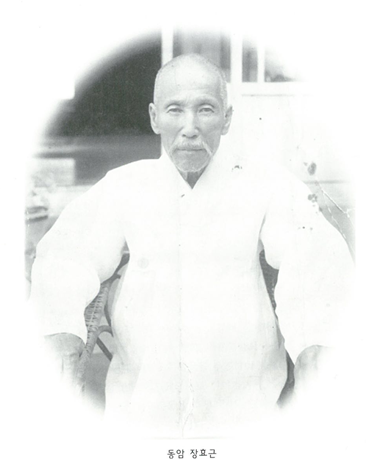
The story of the new Bukhansan Sangyounglu
It was the first time in more than 100 years that Bukhansan Sangyounglu draw dancheong.
In the late Joseon Dynasty, Seongho iik was a teacher of Jeong Yak-yong, Dasan.
Seongho toured all over Bukhansan Mountain and left a record of Samgaksangi.
It was named after 8 scenic views of Bukhansan, the only pavilion
The Sanyeongnu has come up.
Sanyeongru is a pavilion of the Joseon Dynasty, which is located under the bachelor of Nongdong in Doyang-gu, Goyang City. It was named as a mountainous lu because it was shone with a mountain shadow in the North mountain stream running under the mountain sunroof.
Sanyeongru is located in the most spectacular scenery of Bukhan Mountain and is famous for its name.
Sangyoung Lu, who had a lot of poetry people coming and going, looked beautiful at night. It was recorded as one of the 8 most popular mountains in North Korea.
For many years, Sanyeongru, who had been used by many people, suffered a devastating earthquake, except for the foundation stone, when he met the Bukhansan Flood in 1915.
It was designated as Gyeonggi Province Monument No. 223 in 2013 and restored by Goyang City and Gyeonggi Province.
In September of 2018, he was born in a new style with a splendid monocular.
With the harmony with the surrounding nature and pictures of 100 years ago, Sangyoung became the best place in North Korea.

Doona-dong Eunji story
The oldest pond in Goyang City,
Doona-dong Eunji story
Designation number: Goyang City Folk Cultural Property No. 36
Designated Year: 1999
Age: Chosun Dynasty 15th century (1453)
Owned and Managed: Mr. Hansan Lee
ocation: 847-3, Doona-dong, Deokyang-gu, Goyang-si
There is a pond built in Doon-dong, Goyang, 565 years ago.
It is the oldest pond in Goyang City and it is now designated as a cultural asset and protected.
It is the oldest pond in Goyang City and it is now designated as a cultural asset and protected.
The name of the village is also called the dumb-bell, which is how famous this pond is. The total area is 6,600m2, and even after many hundreds of years, the lotus is still planted, and the pond is well preserved.
Carp, carp and crab live in the water, and it is an important place for environment and ecology.
The first person to make the Eunji pond is a scholar, lecturer, and tattoo teacher of the Chosun Dynasty.
Your mausoleum is about 300m southwest of the Ejidipo pond.
The main building of the teacher is Hansan, and the university student of Goryeo is the great - grandson of Lee, Lee. At the age of sixteen, he went to the office of Jungjo, Jungjo of Hojo, Leejo Charm, etc., and carried out a Hwanghae Island Observation on Endangered Territory.
In 1453, when the endangered species was abolished and the slaughtered slain was slaughtered, we began to live in Do - n - dong, where the mountain is abandoned.
And it is called Myeongwol (越 庵) in the sense that it refers to the Yeongwol where the abandonment of his own is abandoned.
After biaxial teacher miss discontinued Great until you go back and I dug the pond and send the rest of his life. It is called a pond called 池.
Eunji pond was famous enough to be shown in the record as well as the old map of the Goyang area.
The best pond in the Goyang area where the prototype remains relatively well, along with the Loyalist Earl who wanted to keep his wages. We tell about story of cultural heritage of Goyang.

Temple site, Hyoja-dong, Goyang
1. Location
Hyoja-dong, Deokyang-gu, Goyang-si, Gyeonggi-do
2. History
Gyohyo-hodja-dong has been known only as Goyang-dukyang-hyoja-dong, and it does not convey its mission and history.
According to the "History and Cultural Remains of Goyang City," published in 1999, the remains were located in the northern part of the peninsula, which runs through the military camps in the "
The site is believed to be a building site, and a fleet of long-storied stone remains, as well as stonework for the building.
Also, relics such as earthenware pieces and scrolls were scattered.
This was confirmed as a limb in April 2017, when an octagonal stone pillar was found behind the "Hyoja-dong" located at the top of the slope.
As it was identified, a relatively large flat surface was constructed on the sides, and a pedestal remained.
Around the stone pillars, famous pastries, new water membranes and chimi were also found.
Back then, experts assumed that the site was a "human investigation" or a Cheong Wa Dae official.
On the other hand, the area around Saji is called Cheongdam-dong, and its name is famous for its outstanding scenery.
Therefore, the literary people did not stop, and there are many touring and paintings.
Among them, Cheongdam-dong Buk-ki in the late Aegean of the Joseon Dynasty is said to have an 'Old Buddha' in the vicinity.
On the other hand, Kim Simin "Cheongdam-ki" depicts the situation at the time when he spent the night eating and eating rice at a temple.
Also, the temple is located on the Daeam (臺 巖), and the location of the temple is in front of you.
On the other hand, in the diary of Shingyu (the diary), there is a temple where monks reside on the east side of the bridge, and the area is very high, looking up from the sperm, and shadows shimmer among the dense trees.
If this is a reference to Hyosajin-dong, it means that the temple was in operation until 1712 when Shimuki visited this place.

Goyang Cyber History Museum recommends summer
In the hot summer, we will recommend some cool and cool places for summer.
1. 600 year anniversary exhibition
It is located on the south side of Janghang 2-dong Park Flower Pavilion in Ilsan-dong, Goyang City. Admission is free. It is closed on Mondays and operates from 9:00 am to 6:00 pm. ou can see major cultural heritages such as Hangju Sungseong, Jukjeonji, Buksansan, Seorungung, Seosungneung, Ilsan Station, and the history of Goyang, as well as the 5020 Koyagi Seongeon which shows the spirit of Goyang city history. There is always a commentary which can help to see and can get various help. On the second floor, there are reference books on history and cultural heritage, and they are used as shelter and library space. This exhibition hall was created for the purpose of knowing the city of Goyang immediately after the 600th anniversary of the use of the name of the Koyang in 2013.
2. Forest and Shade
It is a World Cultural Heritage located in Yongdu-dong, Deokyang-gu, Goyang City. It is called Seorulung, because it is the five faults in the west of Seoul.
Seoryeongneul can walk dirt roads with forest trees such as cedar trees, pine trees, and oak trees, and is good for health, healing and education.
You can get help by talking to the cultural tour commentator at the entrance of the ticket office, if you have any questions about the story of the royal tombs of Chosun, which are walking in the middle of the forest. In the vicinity of the parking lot, there is also the Seolleung Royal Tomb Exhibition Hall, so you can easily understand the royal tombs of Chosun through video and exhibits in the cool interior.
In Seoryeongneung, the most important thing to look at is the Myeongneung, where the 19th Great King Sukjong and Inhyeon Wanghoo of the Joseon Dynasty are asleep. It is located at the entrance of Yeongreung which is the first preserved relatively circular form among the various royal tombs of Joseon Dynasty.
In addition to Myeongryung, Seoryeongneung is also home to Icheon, Gyeongneung, Hongreung and Changryung. The parking fee is free, and the entrance fee is 500won only for Goyang citizens. We recommend Seorungung as a walking course with cool shade of trees.
3. A cool thatched house,
It is located in Jungbalsan-dong, Ilsan-gu, Goyang City.
It is currently protected as a cultural property designated by the Gyeonggi Province and is the only preserved building in the Ilsan new city development process.
It was the only remaining tree house in the shape of an eagle, and it was built as a chestnut.
It is a thatched house that was built about 150 years ago, but the middle part of the roof is open, so it is characterized by cool in summer and warm in winter.
Especially when you sit on the floor, you can see the sky.
The yard of the house is made of clay soil, so the roof, walls and floors are cool.
There is also a cultural tour commentator here, so you can listen to the detailed story, and it is educationally good. Access is good in Ilsan new city. Parking fees and admission are free.
4. Thousand Year Review Gongguksa
Gyeonggguksa is a millennium review under Hanmisan (Nogosan) in Cheonbuk-dong, Deokyang-gu, Goyang City.
It was founded by Ambassador Wonhyo in 661 AD in the Shilla period.
It is cool in the mountains, but you can get to the front of the order by car by car.
It is a temple in the mountain forest. In the afternoon, you can look around for a thousand years in the shade of the forest.
When I open the window to the room, the cool air of the forest comes out.
When you sit on the Hwangguksa maru, you can see many cultural heritages.
The best wooden building in Goyang city built during the Joseon Dynasty year of the Joseon Dynasty can be seen in the history of Heungguksa temple.
On the left side there is Nahnjeon, on the right side there is a namuljeonjeon.
The Amitabha (the Great Synagogue) contains pictures of Buddha and Buddhist statues of Amitabha Buddha.
On the left side of the temple, there is a 250 year old oak tree, and under the shade of the tree are small chairs.
The peaks of Heungguksa and Bukhan Mountain are beautiful and beautiful.
From here, along the meditation path of the forest, go up to Nogosan in about 50m, and the panoramic view from Baekundae on the left to Baekrobong on the right side.
There are about 20 peaks, including Mt. Seonbong, Baekundae, Mangyongdae and Samgak Mountain.
You can admire the cultural heritage of historic Heungguksa along with a healing chair, healing road, and cool scenery that were built in the vicinity of Heungguksa Temple.
At about 6 pm, you can also hear the vigorous singing of Gongguksa, which informs the evening prayer.
Parking fees and admission are free. On weekends, you can listen to the explanation of cultural tour commentator.
5. Sunju Mountain Historical Park and Lee Song Soon Song Duk-bi
I miss the hot summer, the cold winds.
It is a good place to enjoy the Han River in this heat.
There is toilets in park, there are shade of tree and chair and there is hot summer and cool wind.
There is also a variety of attractions to see, such as the shrine of the shrub of the vine, the sculpture of the pinwheel, the dragonfly robe, the independence activist Ahn Chang-ho's country,
In particular, the Han River, which is seen here, was famous from the past.
There is a large parking lot, a grassy plaza and shady shelters everywhere, which is a good place for summer.
In the historical park, the independence activist Yanggok Igo Soon-sung of the independence activist is designated as a cultural asset of Goyang city.
Established in 1950, Sung Dukbee is a magnificent stone statue of Lee Sang Soon who left a great achievement in the irrigation projects in the Goyang area.
In addition to Lee Sung-sung's Sung Duk-bye located at the southeast end of Hwangju Historical Park, Nam-Hyoon of Goyang 8-sincheom, the fertilization of the coal-iodine,
In hot summer, we recommend hot spots in various places in Goyang City.
I hope to have a good time with my family at a low cost.

Goyang 600 years story
Goyang 600 years story
You can easily see the phrases written "100 million happy cities, 600 years culture city" throughout our city. And the residents of nearby cities such as Goyang Citizen and Seoul also often mean 600 years.
In 2018, it will be 1,000 years since the name Gyeonggi province came into existence this year. Various cultural projects are going on in various places in Gyeonggi Province to celebrate this. Goyang City, where we have a population of 1.05 million, celebrated its 600th anniversary in 2013. The year 2018 will be the 605th anniversary of Goyang. From 2013 onwards, Goyang City is continuing its 600-year cultural city project.
We are promoting construction of a history museum that can see the history and cultural heritage of Goyang at a glance.
The 600th year of Koyang means the name of the city of the cat in the history of tens of thousands of years. The name of the cat was first created on March 23, 1417 (1413). Before the name of the cat was made, Goyang City was divided into Kohbon and Deokyang. Kohong is the old name of the present Ilsan area, and Deokyang was similar to the current Duck Yang-gu. The names of these two places have been combined to form the Goyang.
After the first name of the cat, it has not changed its name for the past 605 years. For over 600 years, cats use a single name, which is never easy. Given the artifacts and remains that have been identified to date, the history of Goyang dates back to 70,000 years (the middle of the Paleolithic).
At present, excavation of paleolithic remains is being carried out in the area of Donae-dong, Deokyang-gu, Goyang-si, and stone tools of the Paleolithic Age are being excavated in large quantities.

Dongam Jang Hyo-geun was chosen as the proud figure of Goyang City in 2018.
This year, Dongam Jang Hyo-geun, the proud figure of the city of Goyang, will be introduced.
DongAm Jang Hyogeun (1867 - 1946)
Birthplace Location: 147, Hangju-dong, Deokyang-gu, Goyang-si
Main Activities:
- In 1916, together with Son Byeong-hee and others
- In 1919, the secretary of Boseong Publishing Company
- 3.1 Declaration of Independence Movement Declaration of 21,000 copies distributed, arrested for 5 months imprisonment
- Women's Education, General Education Movement, and Hopeful Activities as Cheondong Bishop
- The second 3.1 movement plan, after dismissal as a dish, and contributed to the first stage
- Armed struggle, including the manufacture of weapons, was liberated during preparation and died in 1946 in cloths
Dongam's Diary: Diary written by Jang Hyo-keun every 30 years from 1916 to 1945
May 8, 2018 Designation (registration) as Cultural Independence Movement Independent Movement (registration) Registration No. 714
He is an independent activist representing the city of Goyang, which received the Presidential Commendation in 1997 and the National Assembly Medal in 1990.
In the Goyang City Culture and Arts Department, we organize various cultural events such as academic presentations ahead of the 100th anniversary of the 3.1 Movement

The story of Sindu-dong that disappeared into history.
On July 1, 2018, Sindae-dong, Deokyang-gu, which had been used for 112 years, disappeared into the back of history.
On September 24, 1906, the name "sindo" first appeared in history as the new Goyang County, Gyeonggi Province. The new administrative district was named after the "God" of the new blood plane and the "Dao" of the Haji-myeon in Goyang-gun. At that time, the shrine was located in the largest jurisdiction of the current city of Goyang, including Bukhansan-dong, Okjeok-dong, Samseong-dong, Dongsan-dong, Yongdong, Hwajeon-dong, and Hyeoncheon-dong. Shindo area was the area with the largest population and the largest area in Goyang county until the mid 1980s.
At that time, the clerk's office in Shindo area was located at the west of the present-day Gwafab station. Then on July 1, 1973, Jingwan Na-ri, Jingwan-ri, and Gupabal-ri of Shin-myeon were incorporated into the city, and Shin-myeon was promoted to the new town for the first time in Goyang County.
On February 1, 1992, the whole of Goyang-gun was elevated to the city, and the new town became Sindu-dong
As a result of the name change, the name of the god was first created in 112 years.
The name of the administrative district has been lost forever.
The new administrative district was named Samsong-dong. On July 1, 2018, Samsong-dong was named as the new administrative district of the area. However, the name "News" is used as a name for Nonghyup and schools, and will not disappear.

Goyang's story of the Korean War - The owner of the North and South changed four times and suffered great damage.
The owner of the North and South changed four times and suffered great damage.
Today is the 68th anniversary of the Korean War.
The war that began on the dawn of June 25, 1950 did not escape Goyang City, which was at the center of the People's Army Base. At that time, the first Korean Army Division was in charge of defense. The division command is located in the current Susaek area. As a result of the surprise attack by the North Korean army, the army was pushed to the Nakdong River, and the UN military started the Incheon landing operation.
The Korean and U.S. Marine Corps will advance to Seoul and restore 9.28 times after the Korean and U.S. naval forces have risen to the Han River in Goyang City.
At this time, there will be fierce battles in Haengjusanseong Fortress, Jeongbalsan Mountain, Gobongsan Mountain, Gaemyeongsan Mountain, and Hwajeongbaebat in Goyang City. The U.S., the Korean and U.N. forces provide Gyeongui Line and Tongil Road to advance northward to the Amnok River and retreat due to Chinese intervention.
Especially, Goyang and Seoul will be under the control of the North Korean military. This is often referred to as a 1.4 retreat.
In order to protect the citizens and their allies from Seoul, the British forces fought in the battle of Happy Valley, and fierce battles were fought in Mt. Pak Dal-san, Maebong, Gobong, Daedeok, Manwolsan and Muyeong-dong. Recently, more than 50 corpses were discovered through the MND project. Water canisters, cookie bags, bullets, bullets, sashes and spoons were also found with the remains. 전쟁 후반기,
In the latter part of the war, the Korean and U.N. forces began to march northward, passing by the Goyang to the Imjingang, Cheorwon and Yanggu.
The fighting continues in Paju, Ganghwa, and other cities near Goyang City.
And on July 27, 1953, in the middle of summer, three years of war went into a truce. The three-year war left the cat with a big, small pain.
The consequences of the conflict between the residents, countless orphans, leftover weapons and debris wars were horrific.
After overcoming the pain and hardship, as of June 2018, the mood for peace and unification has been high, with the heads of state talking. The path toward peaceful unification, freedom and prosperity is being gradually taken from confrontation, division, antagonism and strife. Tragedy should never happen again, such as the Korean War. Communicate and talk to each other and wait for the day when you can travel between Pyongyang and Sinuiju via Kaesong by KTX bullet train.
Photo Marine Corps Cost of steel a victory a cloth







